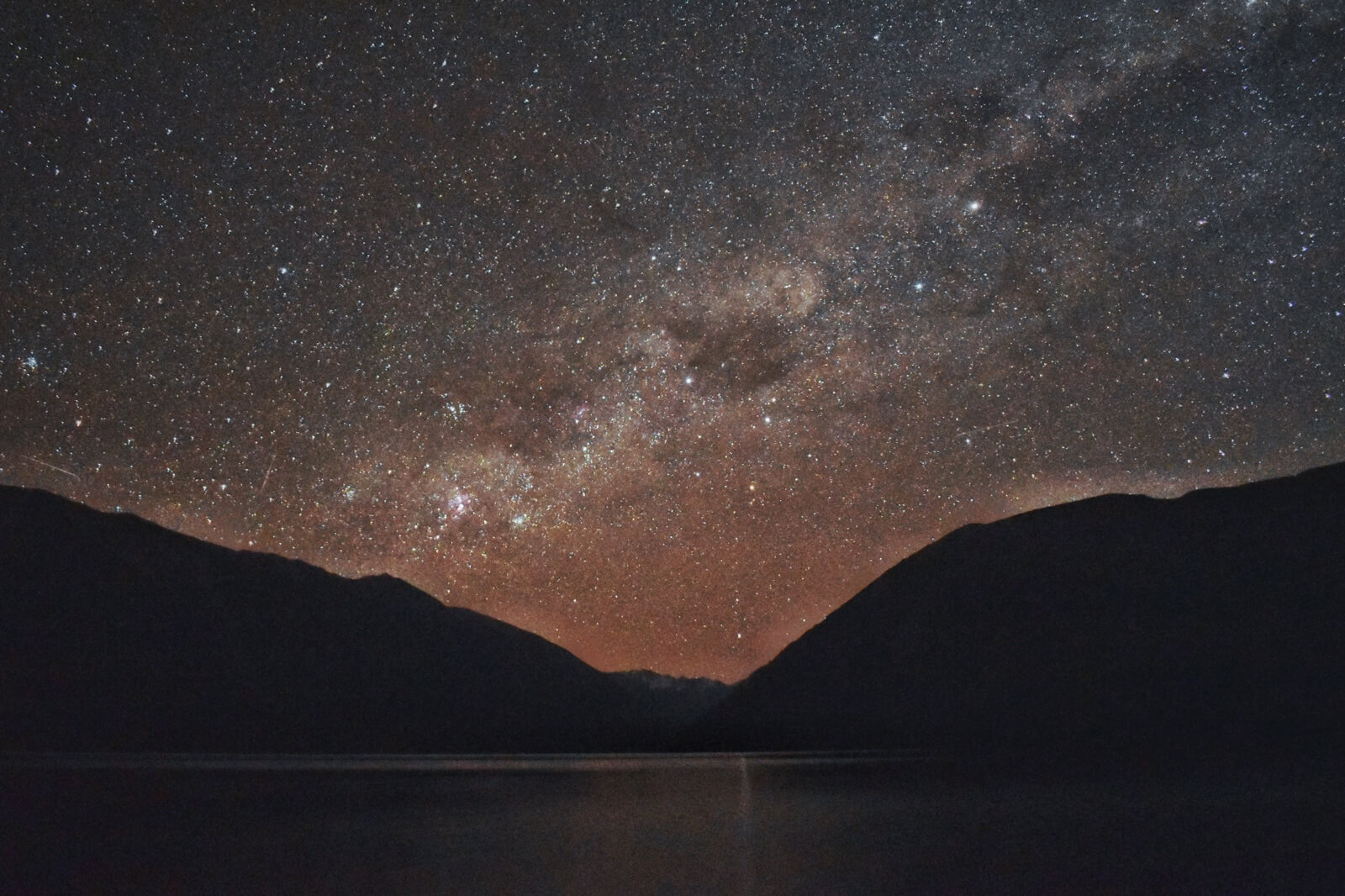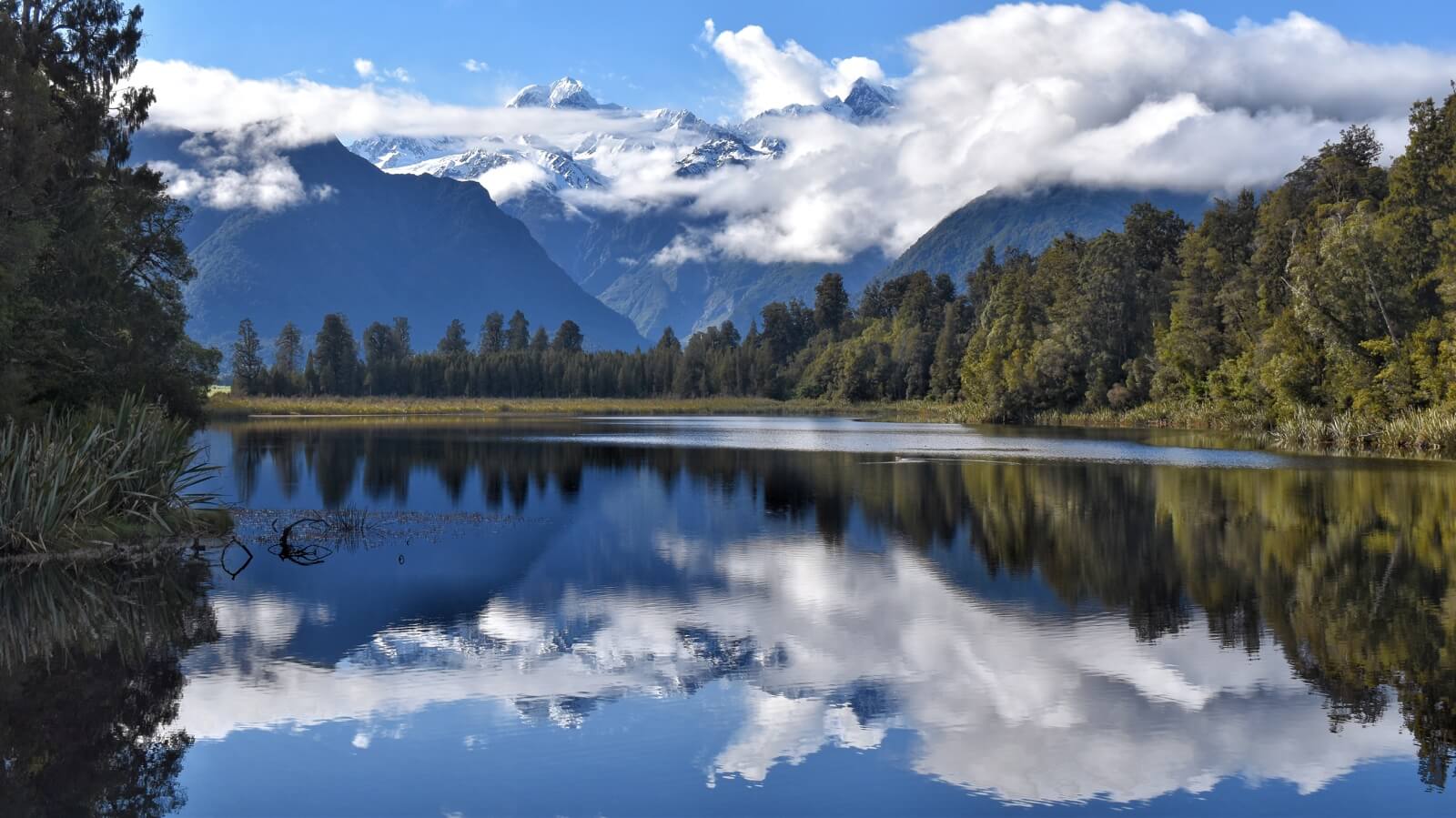The drive down the South Island's West Coast region seems to be notorious amongst Kiwis for two things. It's one of the country's most stunning routes, but also only shows itself infuriatingly rarely. Would we be able to see the peaks reflected in the mirror lakes? Or would it just be cloud?
After Adrian's walk we stayed in Nelson Lakes Park for a bit longer to do another great hike, up Mount Robert, and to do some star gazing. On the South Island, it seems like everywhere is a good stargazing spot as long as the weather is right, but being right on a lake definitely helped. Unfortunately, the constellations you can see in the Southern Hemisphere are quite different from the ones we're used to, and even a star map we found online was not much use. In blissful ignorance of what we were looking at we still enjoyed staring at the twinkling sky and the starry reflections in the lake, and trying to catch all of this on camera. By the end of the night we were stunned, not just because of the beauty, but also because of the cold.

In the Nelson Lakes visitors centre, we saw some familiar faces: the cloud gazers from Mount Stokes had followed us once again. Over the past few weeks, we have encountered a some more people who seem to appear wherever we are. A girl travelling alone in a car. Two Dutch people in a pleonastically called ‘Hippie Van’. We know that they are Dutch, and they probably know one of us is Dutch, but do they know that we know that they know?
We even saw some of them when we left the tourist trail to go to a slightly less popular national park in the North of the West Coast. In Oparara, where the flora looks a bit more tropical, you can have a look at some very impressive caves and natural arches. You can just enter the caves on your own with a torch to have a stroll around and look at spider eggs hanging from the ceiling like tea bags. No entrance fee, no graffiti… Only in New Zealand. We stayed in the town of Karamea, which has some small hotels and tourist information, but also very much looks like a place that people live in. It has a school, a police office with a lovely garden, and a meeting place for local seniors in the living room of our camping spot.
On the West Coast we also encountered the famous sandflies we have been warned about. They are like smaller mosquitoes that can operate in swarms and leave very itchy bites. We haven't seen great groups of them yet but they are persistent, especially when it starts to get dark. When we sit in the camper van at night we can see them gathering on the windows like in a horror film. Our only ally is a lazy spider that lives in the ventilation area but as far as we can see his web is not up to scratch. We could import another spider to create some competition, but if a month in New Zealand has taught us anything it's that human interference in the natural balance of the world only leads to trouble. The roads are lined with the corpses of possums to attest to this.
One of the big items on our wish list was the glacier region, and when we saw a nice weather window opening up we decided to rush down the West Coast to be there in time for clear skies over ice. With success! We managed to go have a look at both the twin glaciers Franz Josef and Fox and some lookout points and see impressive mountain formations in the distance.

The villages around the glaciers are very different from Karamea: every building is either a helicopter hire place, a hotel or a restaurant, and it is hard to see where anyone working here actually lives. ‘It may look busy, but this has always been a popular tourist destination’ says a poster in the information centre, along with pictures of people standing on the ice in the 19th century. Those first visitors had a lot more ice to play with than us: the glaciers always move quickly but have retreated especially fast in recent years. At the time the Grumpy Dutch Guides graced the area with their presence you could still go on hikes up to the ice, but in 2017 the only way to get your feet on the ice is by helicopter ride. And they are very popular: at some points all these helicopters make the quiet towns sound like Central London on terror alert. On all walks in the area there are signs explaining why the helicopters are there and reassuring phrases such as ’there will be quiet times’.
Some master spin doctor has been involved in design of the information boards, focusing on the positive aspects of the glaciers looking different every day. What used to be a viewpoint next to the glacier is billed as a great opportunity to track the progress of the glacier: you get some pictures of whiter times and the tip of the glacier in the distance. Still, what you can see of the ice is beautiful and the retreating giant has left behind some very impressive rock faces.
The one sunny day we caught was followed by low hanging clouds. Thankfully, we did a hike to Roberts Point (a viewpoint looking out at one of the glaciers) that had a lot more entertainment than just a simple view at the end. Big rocks to clamber on! Swing bridges! Wooden pathways attached to the side of rocks! We were rewarded with a viewpoint with picnic benches and a Kea, the resident cheeky bird.

The next few days also look grey so we will hit the road again. Next stop: Mount Aspiring National Park, with more mountains, fewer sandflies, and hopefully some more lessons in star photography.